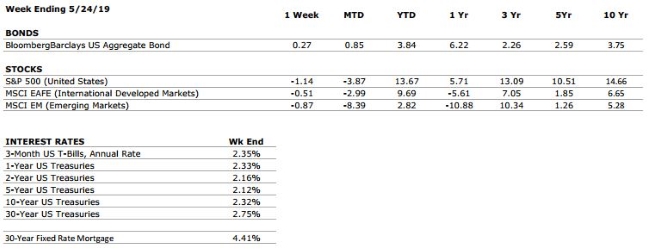by Connor Darrell CFA, Assistant Vice President – Head of Investments
Geopolitical Update: China & Iran Represent Risks
We have raised our “International Risks” rating to a 7 from a 5 following recent developments in the Middle East and escalating tensions between the United States and China. We continue to stress that geopolitical events tend to have a smaller impact on markets than fundamental economic factors such as GDP, corporate earnings, and consumer confidence, but believe that recent news flow warrants investors’ close attention.
Earlier
this month, the Trump administration ordered the deployment of significant
military assets to the Persian Gulf, citing intelligence that suggested a
rising probability of Iranian attacks on U.S. interests in the region. The
Iranian economy is under significant pressure as a result of U.S. sanctions,
and there appears to be growing concern within the Iranian government that
Donald Trump will be re-elected in 2020. We have already seen multiple
instances over the past few weeks where Saudi oil assets were sabotaged, and
the general consensus in the intelligence community is that these attacks were
carried out by Yemeni rebels on behalf of Iran. U.S.-Iranian relations are at
their weakest level in years, with Secretary of State Mike Pompeo and Iranian
Foreign Minister Mohammad Javad Zarif never having directly spoken to one
another. The lack of a direct channel of communications between the two chief
diplomats underscores a growing concern that any potential confrontation may be
blown out of proportion and escalate quickly. Any meaningful escalation of
tensions in the region would have the potential to de-stabilize oil prices (20%
of the world’s oil travels through the Strait of Hormuz on its way to end
markets) and further strain the United States’ relationship with China.
The
trade negotiations between the U.S. and China have been thoroughly explored in
virtually all media outlets, as well as in previous iterations of The Weekly
Commentary, but there is another dimension to the discussions which extends
beyond trade deficits and trade surpluses; the race to 5G. It has become
increasingly apparent that the United States government views the race to
establishing and dominating the world’s first 5G (fifth generation) cellular
network technology grid as a matter of national security. First adopters of 5G
technology are expected to sustain a meaningful long-term competitive
advantage, and China is heavily focused on pushing to challenge the United
States as the dominant force in the evolution of the world wide web. China’s
approach to controlling information on the internet is vastly different from
the openness championed by traditional American values, and in many ways, the
race to 5G represents a philosophical battleground over the flow of information;
one that has continued to escalate in recent weeks.
Shortly
after the most recent round of trade discussions fell through, President Trump
announced a ban on Chinese smartphone manufacturer Huawei. The ban blocks U.S.
companies from doing business with Huawei, and essentially prevents it from
accessing key inputs to its manufacturing process (which are produced by
American companies). We see this decision as a clear and meaningful step to
explicitly hamper China’s advancement in 5G technology and keep U.S. companies
on a level playing field (Chinese companies receive direct support from the
Communist-led government).
From an investor
perspective, a meaningful disruption to the supply chain of technology
equipment or additional bans would have the potential to cause volatility in
equity markets as companies’ revenue streams are impacted. Even if a trade deal
is reached within the next several months, the complexities of the
technological rivalry between the two countries is likely to persist and will
represent potential challenges for global companies which may be caught in the
crosshairs of further policy action. Furthermore, a prolonged period where
tariffs are imposed on Chinese goods would likely have a negative impact on
economic growth. Recent research published by the New York Fed estimated that
the newest round of tariffs could cost the average American household $831 per
year. The focus on China and trade has the potential to draw the market’s focus
further away from fundamentals and toward the unpredictability of the
president’s Twitter feed. Such an environment will be very difficult to
navigate for market timers and short-term traders. In our view, the best defense for this type
of uncertainty is broad diversification and discipline. We will continue to
utilize The Weekly Commentary to share our thoughts on new developments as they
unfold.



